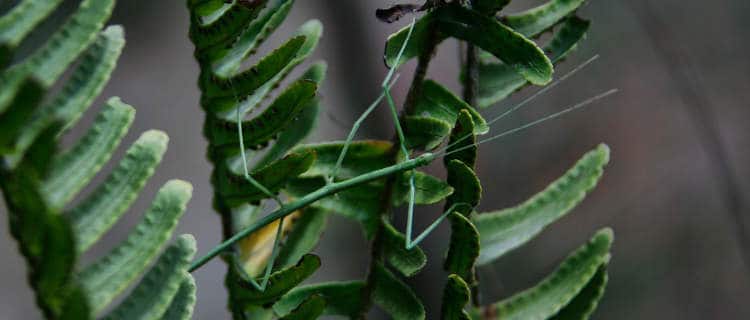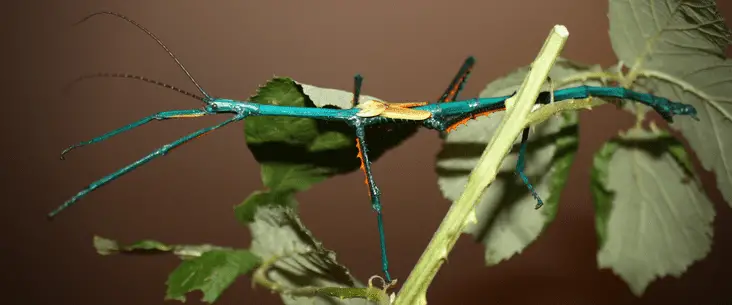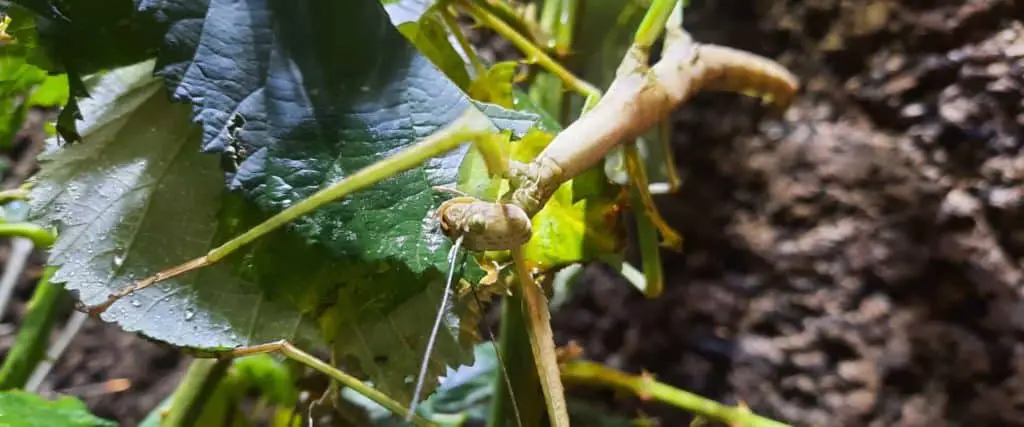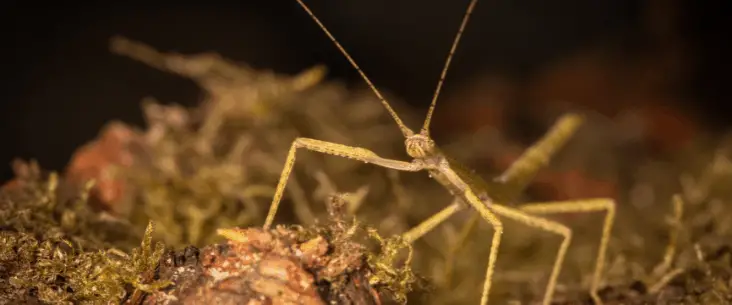Did you decide to keep stick insects? Awesome! Stick insects are great pets to have. Easy ones too. Stick insects don’t have high requirements, but it is important to have a good start. Setting up your enclosure properly is one of those things that you should have right from the start, to prevent problems in the future. Are you wondering how to house your stick insects?
Although there are some crucial choices to make and several requirements that should be met, setting up a good stick insect tank is not that difficult. In this article, we discuss 7 steps to get you quickly set up to house your new stick insect pets. Ready? Let’s go!
Do you want to know all about caring for stick insects?
Quick question: Are you new to keeping stick insects and want to know all the things about keeping and caring stick insects? Although this article is filled with plenty of practical tips, I can recommend you to read to basics guide on keeping and caring for stick insects!
#1 Choose between natural or practical setup
One choice you have to make from the start is if you go for a natural (aesthetic) setup, or that you want to make it (more) practical and easy?
Everyone keep insects for different reasons. Do you want to keep stick insects to observe their beauty and amazingly strange shapes? If you want to enjoy the scene of stick insects fully, you should choose a natural setup. Although it can cost a bit more, your stick insect tank can be a centrepiece in your living room.
Rather like to build up a collection, breed with them or want to keep them on a lower budget? That’s also fine! This option will give you more flexibility in how to house them and make it (a bit) less time consuming to keep and care for them.
It is important first to decide why you like to keep stick insects before we go further to set up your stick insect enclosure.
#2 Pick a suitable enclosure (type and size)
The enclosure is the fundament for keeping your stick insects healthy and happy. It all starts with the housing. There are two things two consider here: Enclosure size and enclosure type.
Which enclosure size is needed for my stick insect?
First, you need to determine what the size should be of your enclosure. There is a simple rule so you can calculate the minimum size needed. For a couple of stick insects, the size of the enclosure should be 3 times the adult body length in height, and 2 times the adult body length in width. The size of the enclosure directly depends on the size of the species.
For example, if you want to keep giant prickly stick insects (Extatosoma tiaratum) which can grow to 8″ (20cm) long, you need an enclosure that is at least 24″ (60cm) tall and 16″ (40cm) wide. If you like to have more than two stick insects, you should consider an even larger enclosure.
You might be wondering why the enclosure should be taller than wide? The height is needed for stick insects to have enough space to shed their skin. When a stick insect is going to moult, it will hang upside down. It then slowly free itself from its old skin with the help of gravity. If you are not providing this height, your animal may become stuck in its own skin or may get malformed.
What type of enclosure should I choose?
So now we know what size is needed, we can choose a type of enclosure. Yes, there are different types of enclosures to choose from. We can distinguish roughly two types of enclosures: terrarium tanks and netting cages.
With step 1, you decided if you want a natural setup or a practical setup. A terrarium is most suitable for a natural setup but is also more pricey. A netting cage can be more practical and also cheaper than a terrarium tank, but visibility on your animals is not that good. Although it is personal taste, a netting cage is also not appealing to place in your living room.
The enclosure needs some requirements to make it suitable for stick insects:
- The height is more important than the width.
- Preferably the roof or lid of the enclosure is made of fine mesh.
- Have good ventilation capacity.
- Is escape-proof, even for (tiny) baby stick insects.
- Is easily accessible from the front or the top of the enclosure (preferably from the front, or both).
Besides terrarium tanks and netting cages, you can also choose to repurpose an aquarium tank, use an acrylic/plastic tank or build a custom-designed enclosure. For all of these, you still need to meet the requirements mentioned above.
#3 Choose a substrate
If you found a suitable enclosure, it is time to create the perfect habitat for your stick insect. It starts with a substrate. Although a substrate is not vital, it is recommended to have one. A substrate contributes to maintaining a higher humidity, which is preferred to keep stick insects healthy — more on that in step 5.
However, a substrate can be more than potting soil. When you want to create a natural-looking habitat, I recommend you to use white (aquarium) sand or coconut fibre. Potting soil and compost can also be used. Avoid products like wooden chips, gravel and pebbles.
If you wish to keep them in a more practical manner, you can also use dishcloths or paper towels as a substrate. Although visually unattractive, these products make it easier to clean (and to find eggs if you wish to breed with your stick insects) and also helps to maintain the humidity. Within a netting cage, these substrate products are the way to go.
Some stick insects burrow their eggs. If you keep such a stick insect, you need to provide a substrate of sand or related products to be able to dig in the eggs. Within a netting cage, you can also provide a bowl with a substrate for them.
#4 Furnishing and decorate the enclosure
Now it is time to add furnishing to the enclosure. Actually, stick insects are quite easily pleased. With some branches to hang on, they have all they need. Place two or three branches from the bottom to the top, with some side branches on them. They use these branches for sitting and for resting. When you go for a practical setup, then you are done and can go to the next step.
Although with feeding you also provide branches (with leaves), it is still recommended to have some additional bare branches in the enclosure. Another possibility is to add a cork background for them to climb on, but this is only suitable for a terrarium tank (and should be done before placing the substrate in).
If you like to recreate a more natural look in the enclosure, you can add some more decoration. Think of a bit of moss on the substrate, some live plants that or not poisonous to stick insects but are also not eaten.

#5 Preparations to easily feed your stick insects
When you set up a stick insect enclosure, you need to make some preparations to make it easier to feed them. Stick insects are herbivores, and only eat the leaves of specific plants. But, they only eat fresh leaves. When they start to wither, stick insects stop eating from it.
So we need to keep the leaves fresh and green as long as possible. Luckily it is quite easy to do so. You have to do two things. First, you need to spray the leaves to keep them moist, but it is also important to keep the leaves (with stem) in a vase, bottle or jar.
It would be best if you found a suitable vase or something similar to place the branches with leaves in. You can use a simple plastic bottle, or a more good looking (pottery) vase. Before you fill it with water, put in some sand or gravel to heavy the bottom. It prevents that the vase will tip over when you fill it up with branches.
There is so much more to learn about food and the feeding of stick insects. I can advise you to read our feeding guide for stick insects. It is packed with practical tips about feeding and provides a list of food items that are best to feed stick insects.
For the preparation of your enclosure now, it is only important to find something to place your leafy branches in. The enclosure is actually ready now. But there is one more step to do before it is ready to house your stick insects.
#6 Maintain a proper temperature and moisture level
There is one last step to cover before the new home of your stick insects is ready — create a proper environment for them. The environment exists of three important elements that need attention: temperature, humidity and light.
Temperature
With many stick insects comes many different temperature requirements. Most stick insects can live perfectly at room temperature or slightly above (between 18°C and 25°C — 64°F and 77°F). However, there are some species that require higher temperatures in the 24°C and 28°C (75°F – 82°F).
It depends on the ambient temperature where you plan to house them if you need additional heating. The heating of the enclosure is quite simple. You can use a regular light bulb between 35W and 50W. Nothing special, nothing more. That should generally be enough. If you keep them on a location that is quite colder than room temperature, or you want to keep a stick insect that needs more tropical temperatures, you can use higher wattage light bulbs.
You don’t want to have the light on for 24h a day. A heating pad underneath or on the backside of the enclosure can help to maintain the temperature during the night. Although you can let it cool off a bit at night, you shouldn’t keep them in the cold.
Humidity
Overall stick insects like a more humid environment. Spraying water in the enclosure helps to maintain the correct humidity. It is advised to spray the leaves you feed before placing them in the enclosure, and this also contributes to higher humidity.
We already talked about it that a substrate benefits the humidity as well. Although a substrate is not explicitly required, it increases and maintains the humidity for your stick insect. Spray water on the substrate to make it damp (not soaking wet). The substrate slowly releases the moisture, maintaining the humidity over a longer period.
Light(cycle)
Stick insects need light. They need light to stimulate breeding and the dispersal of eggs, but it is also believed that the light cycle will stimulate normal behaviour and eating patterns.
You often provide light already because of the heating of your enclosure with a regular light bulb. If you don’t need additional heating, use a LED light that doesn’t radiate much heat. Also, place the light bulb a bit further from the enclosure can help not to overheat the enclosure.
A normal light cycle of 12h “daylight” and 12h dark is perfect. Although stick insects need light, they also need night (dark) hours. Stick insects are nocturnal, and mostly eat, breed and drop eggs during these dark hours. If you keep them in a lighted enclosure for 24h is unhealthy and will make your stick insects unhappy.

#7 Introduce your stick insects
Your enclosure is now ready to welcome the new inhabitants. If you followed all steps, you have provided the stick insects with all they need.
You can now put in the first food and carefully place them on the branches with leaves. It is absolutely critical to observe the animals closely the first days, to see if they find their food, if they won’t escape somehow and if they are happy with their new enclosure.
It is time to enjoy your new pet friends and keep them well fed. Observe and enjoy their incredible behaviour like ‘rocking’, going through their first moult, and see them happily nibble on the fresh leaves. If all goes well, you will quickly find the first eggs!
Want to know more?
If you want to know more about all there is on keeping and caring for stick insects, then check out our basics guide on caring for your stick insect. This guide will help you with all you need to know and provide many practical tips and tricks on the best care for stick insects.
Do you wish to breed with your stick insect? Although stick insects are breeding quite easily, there are many things to think about. Go check out our guide on the basics of breeding stick insects. You will be better prepared for baby stick insects.
Share this page!



